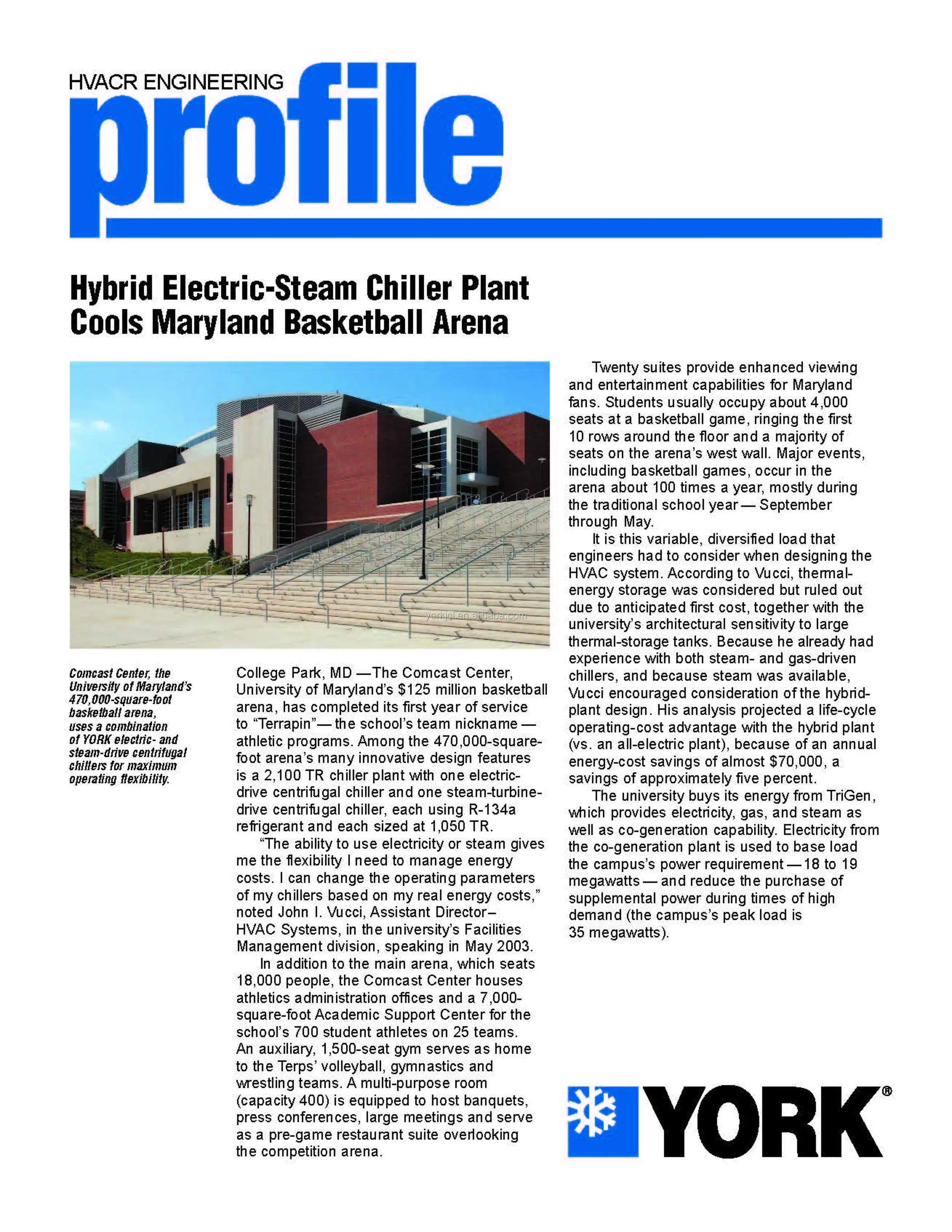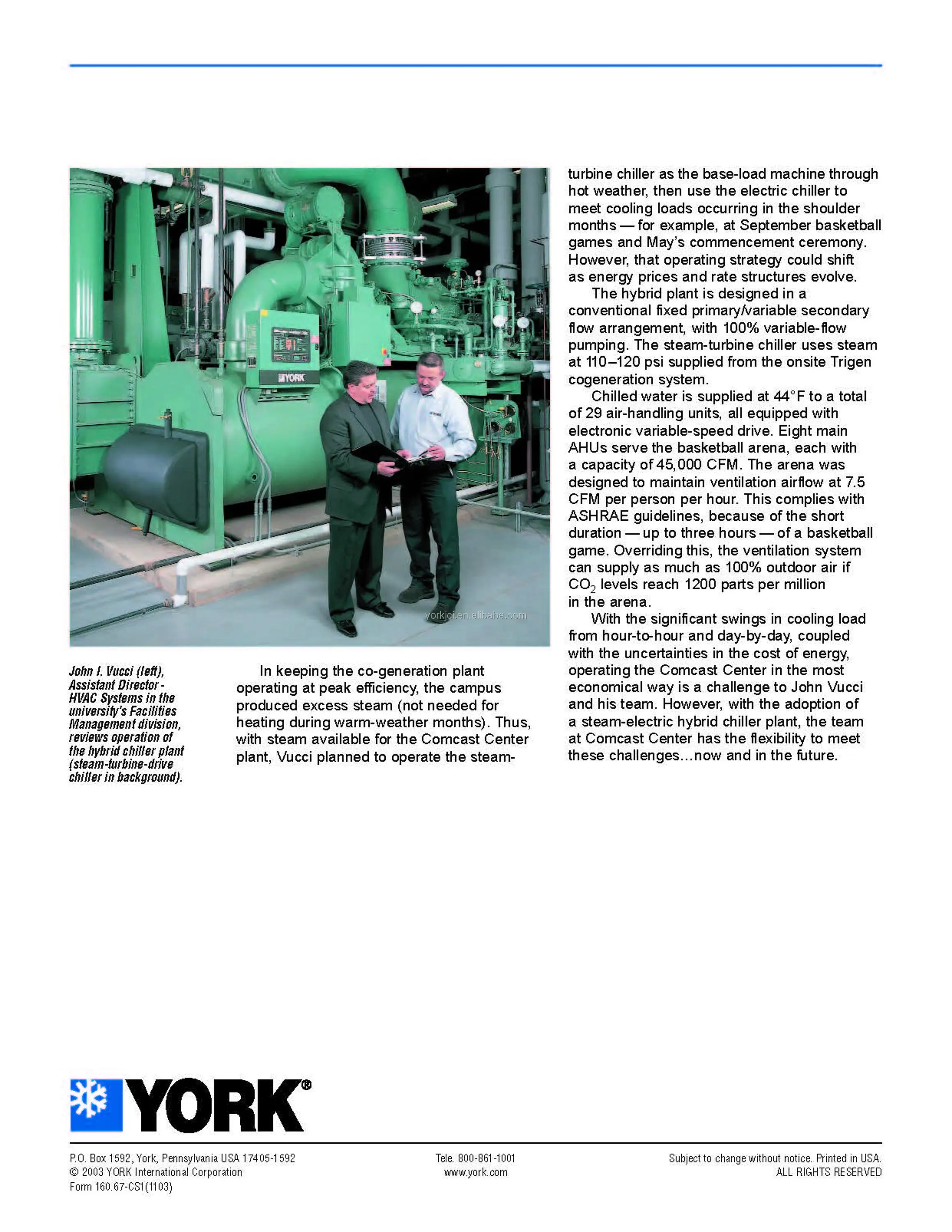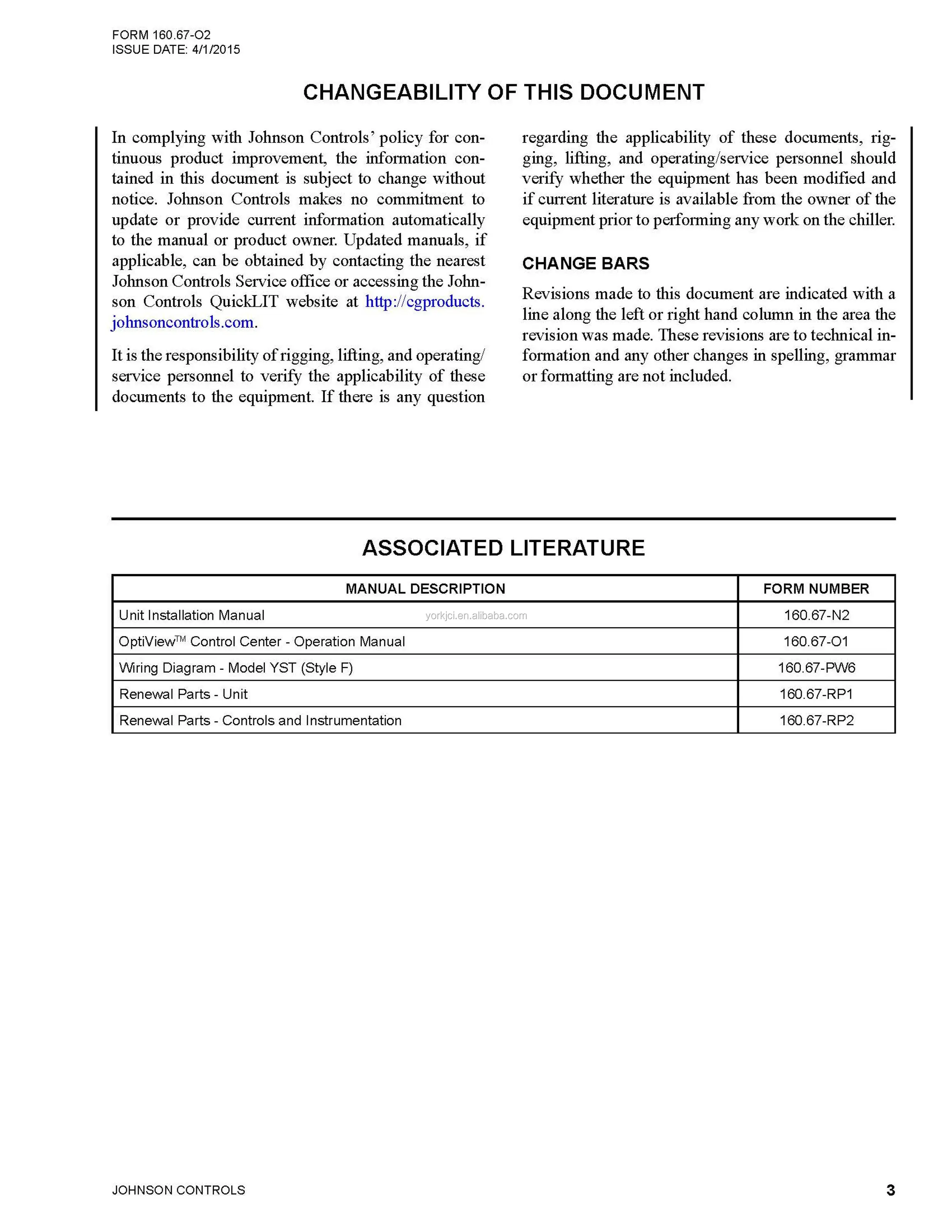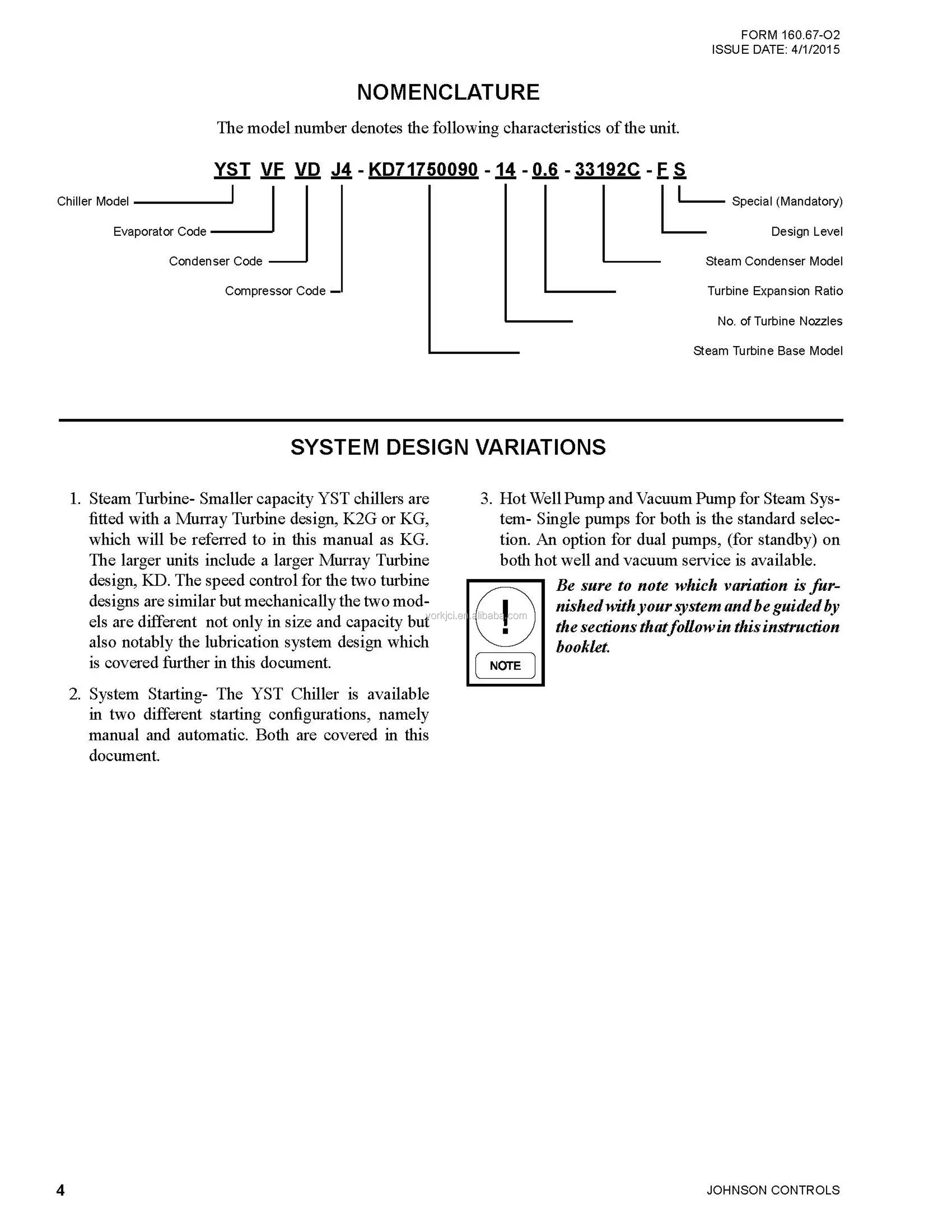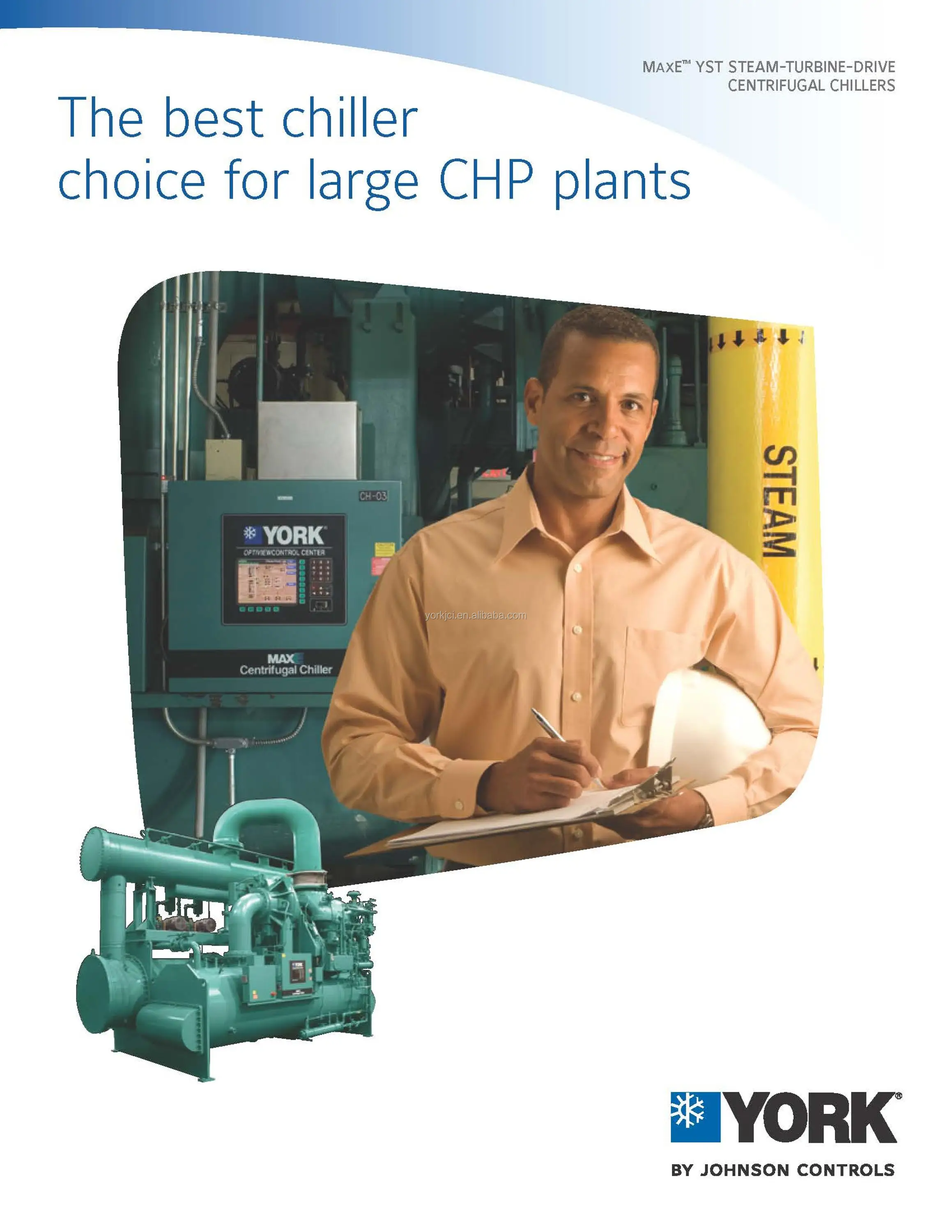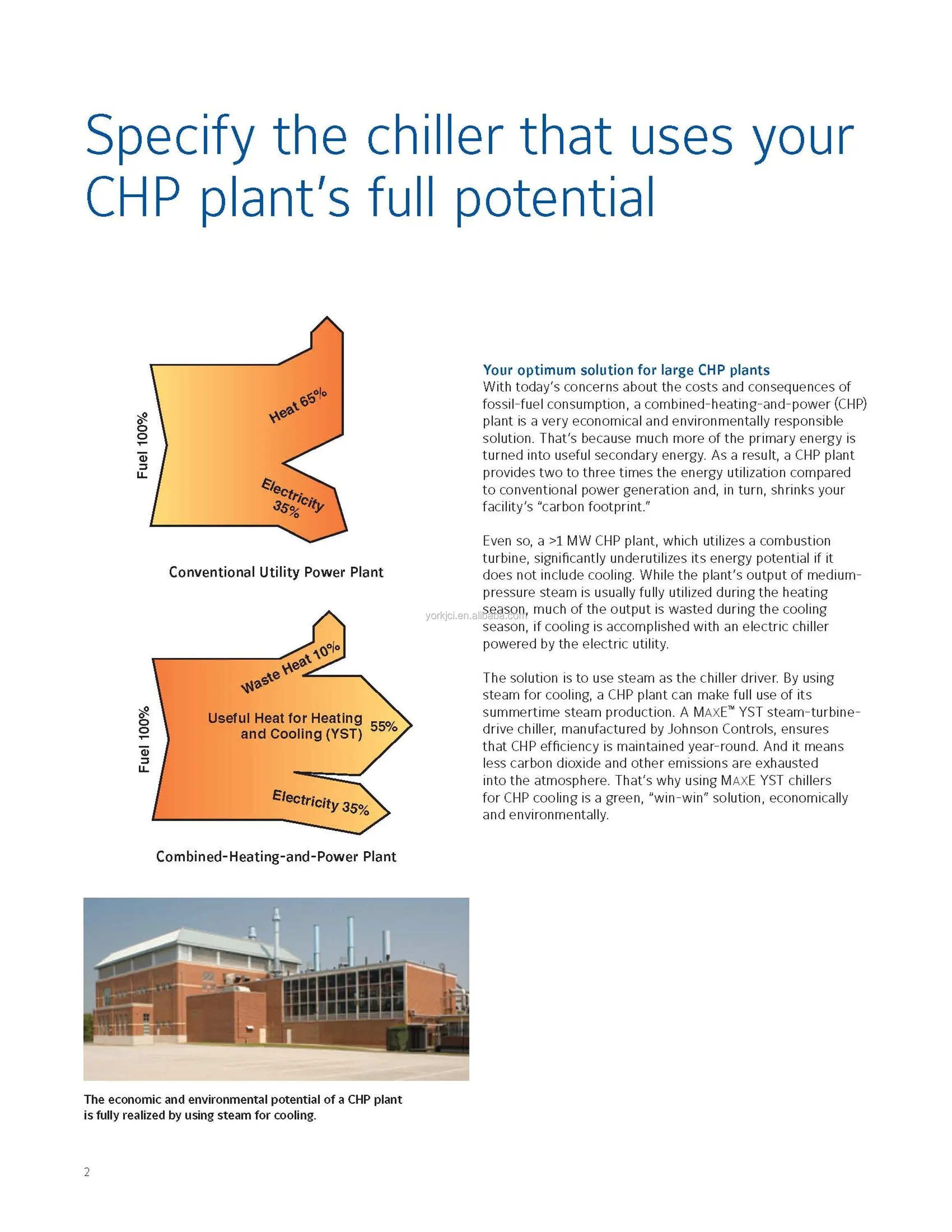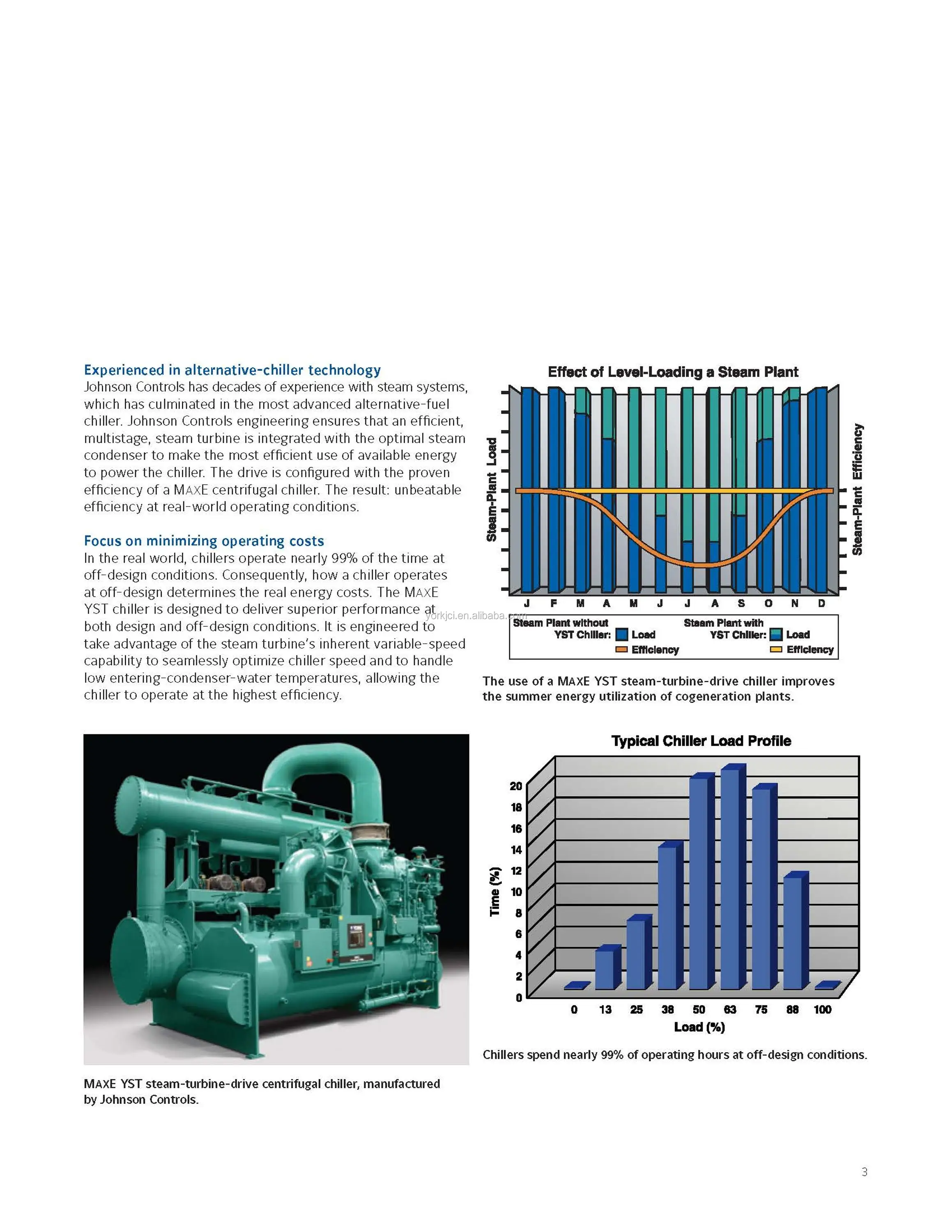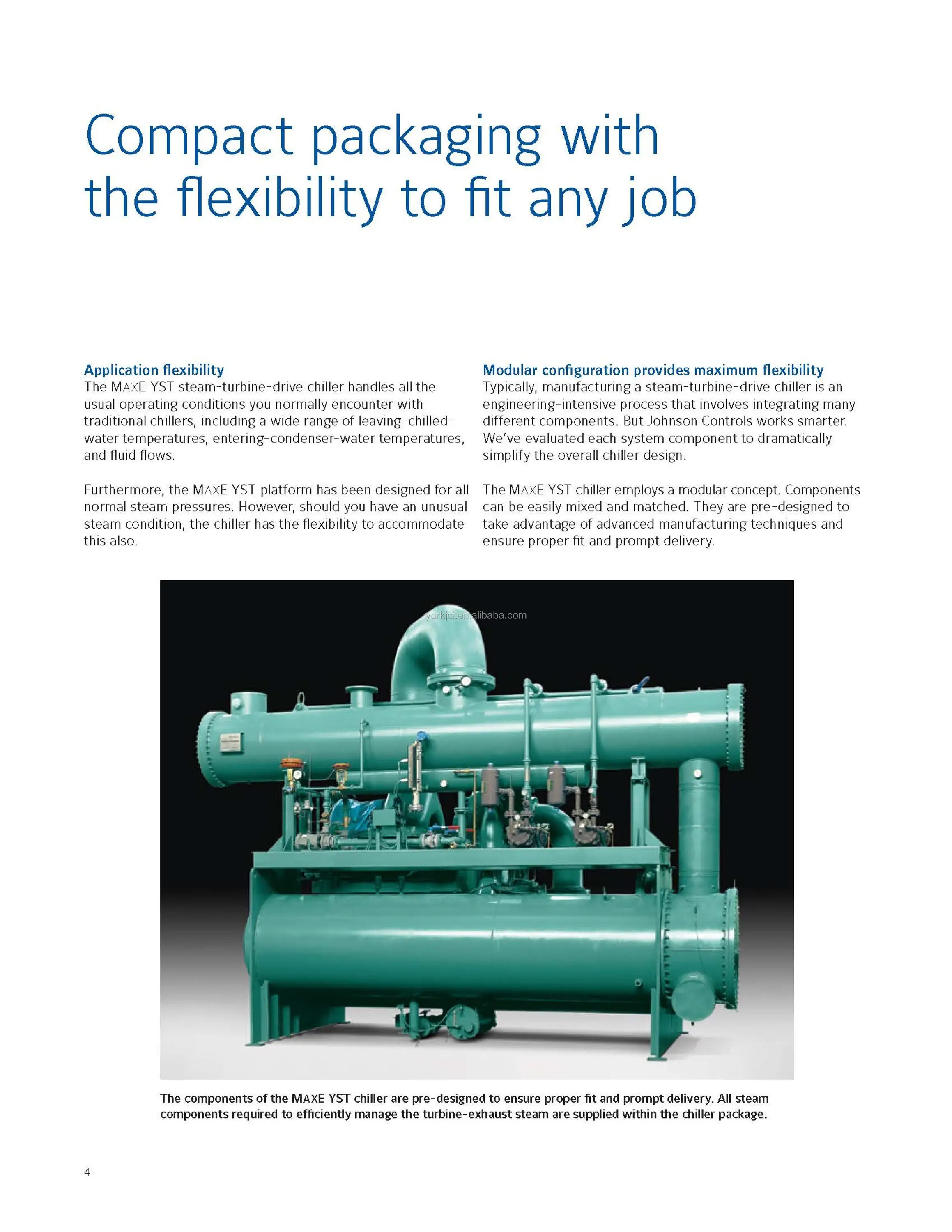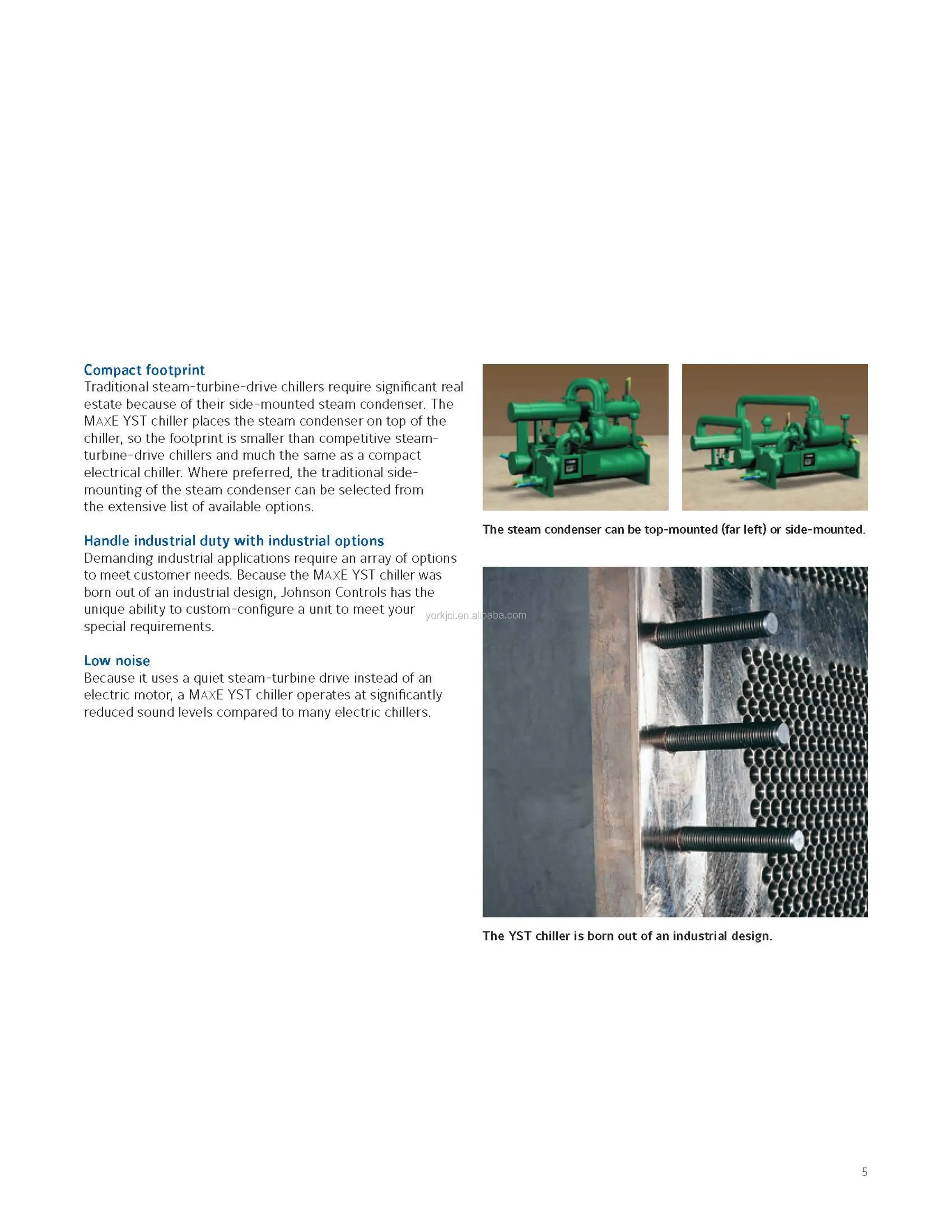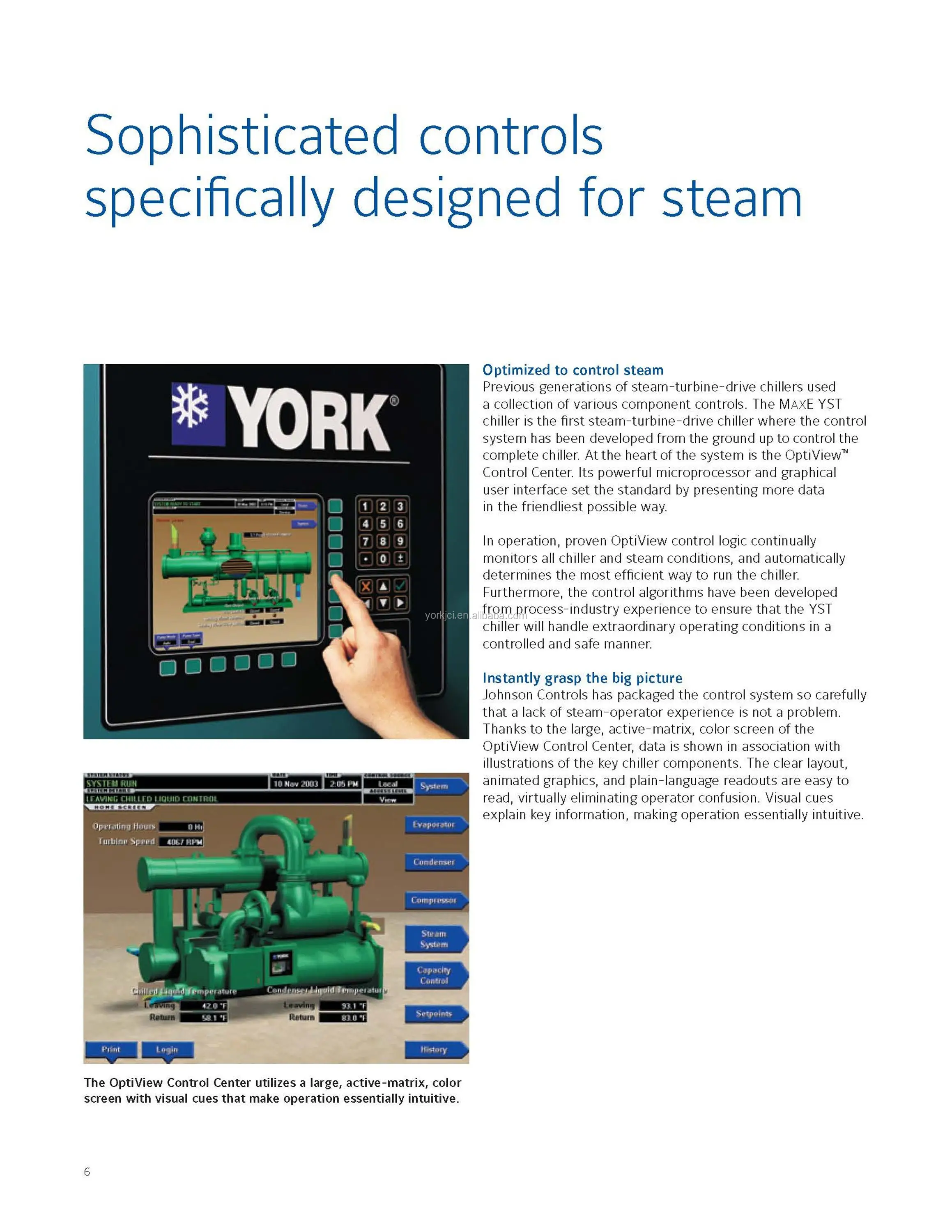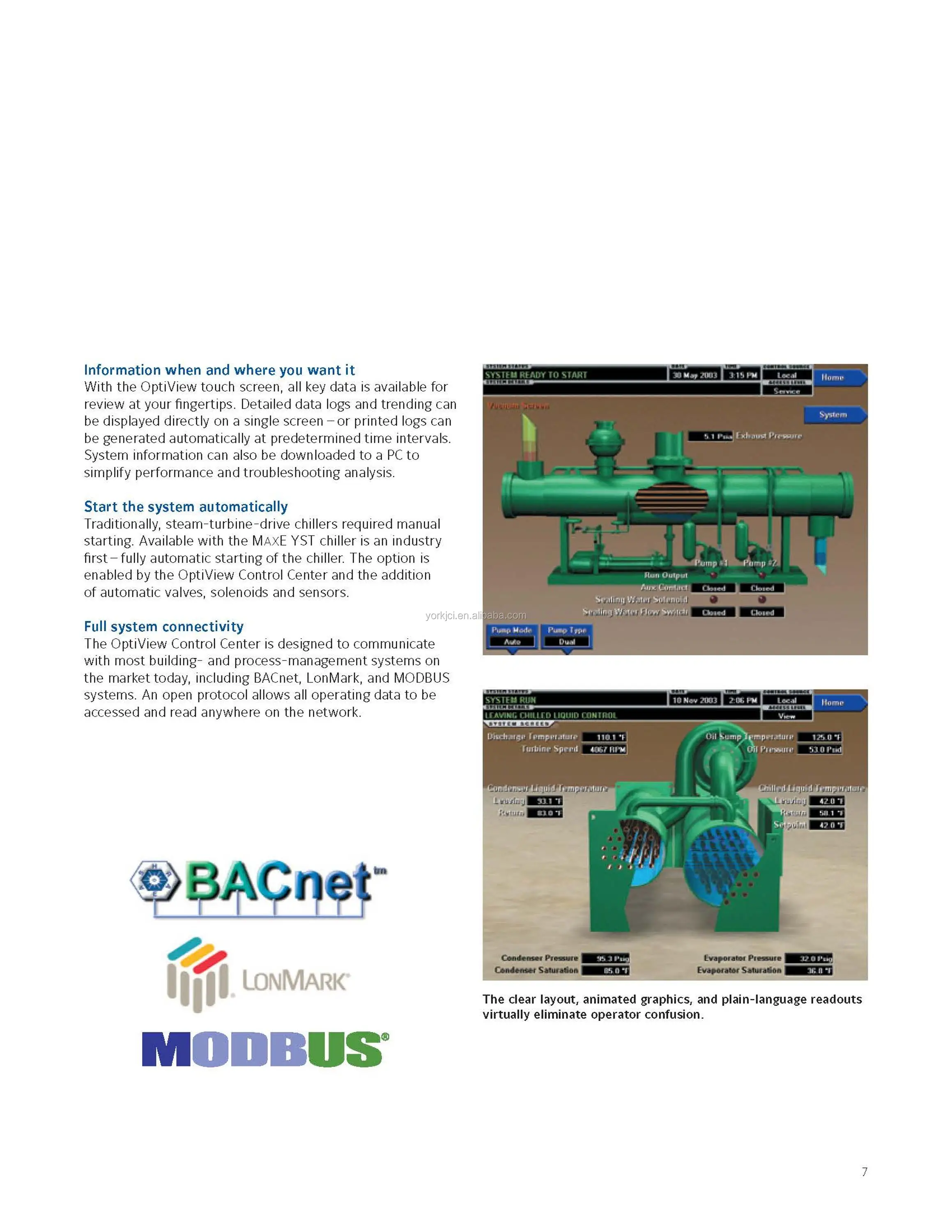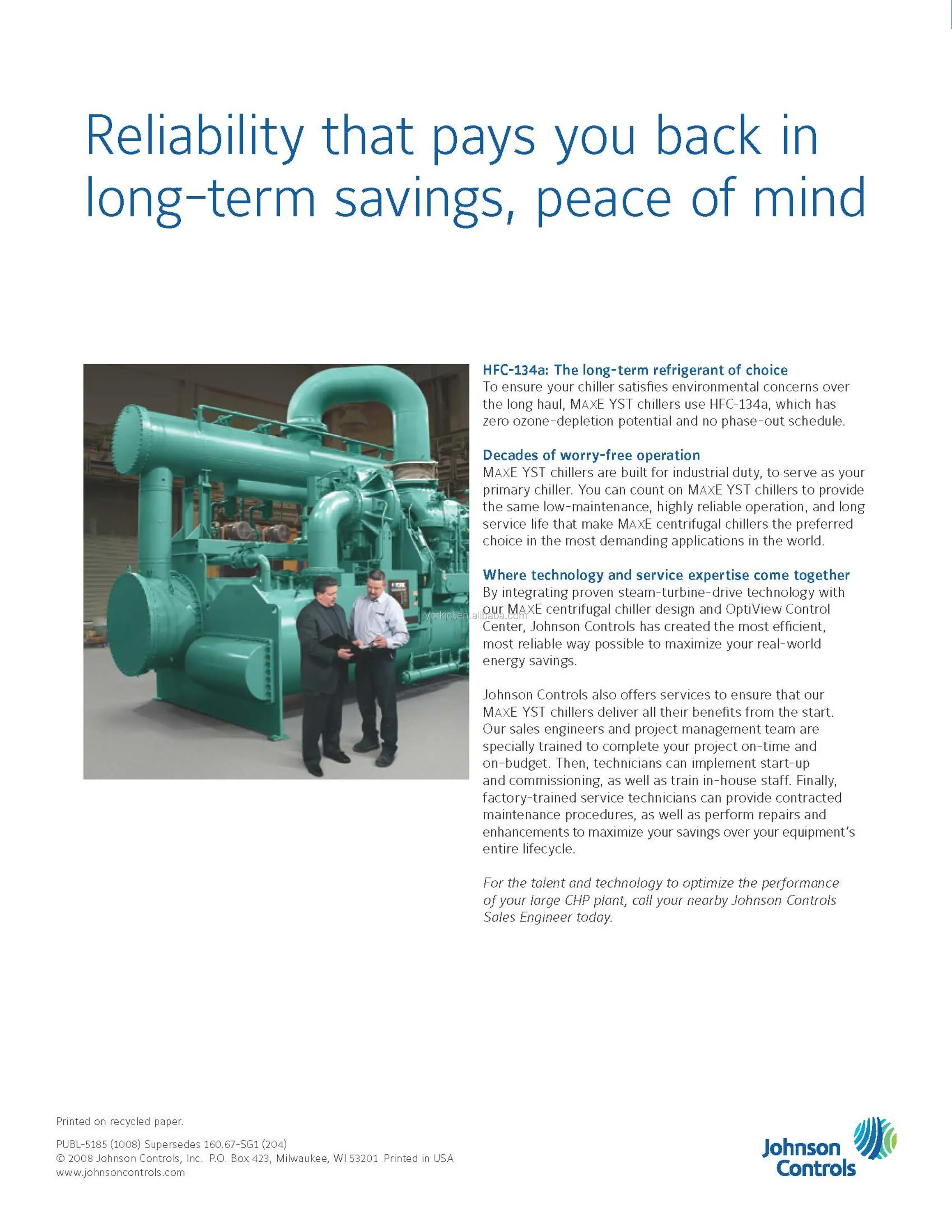
Brand Name: YORK
Model Number: YST VF VD J4 - KD71750090 - 14 - 0.6 - 33192C - F S
Place of Origin: Jiangsu, China (Mainland)
The perfect choice for large combined-heating-and-power (CHP) plants, our YORK® YST Steam Chiller ensures that CHP efficiency is maintained year-round, which means less carbon dioxide and other emissions are exhausted into the atmosphere, making it the truly green solution.
At Johnson Controls, we've manufactured the YST Steam Chiller to use your CHP plant's full potential. Featuring compact packaging and the flexibility to fit any job, our steam turbine chiller is easy to own with sophisticated controls specifically designed for steam.
A
By ROY S. HUBBARD
Johnson Controls Inc.
York, Pa.
As the cost of energy continues to rise, it behooves
chiller-plant owners and designers to consider the
energy impacts of virtually everything under their control,
including chilled-water piping.
This article will discuss the energy consumption of
the three basic configurations of chilled-water piping
currently in use: constant primary flow (CPF), constant
primary flow/variable secondary flow (P/S), and variable
primary flow (VPF). Also, it will discuss the attributes
of equipment-room space, installed cost, and control
complexity.
Constant Primary Flow
Operation. Figure 1 illustrates a
CPF arrangement at 100-percent
system load. The most basic of the
three configurations, this is used
in many smaller plants. As the name
implies, the chilled-water (CHW)
pumps are constant speed, and water
flow varies only when a chiller and
its pump are cycled off for capacity
purposes.
Throughout this article, the following
formula will be used to analyze
how systems operate:
Load = Flow × Delta-T
where:
Delta-T = chilled-water-temperature range
In a CPF configuration, load changes are reflected
by changing delta-T. Typically, a three-way valve is
placed on the discharge of each coil. The valve’s job is
to maintain the set-point temperature of the air leaving
the coil. If the temperature of the air ventures above
or below its set point, the valve modulates the amount
of chilled water flowing through the coil, with excess
water bypassing the coil. This modulates the temperature
of the chilled water within the coil in accordance with the
formula above; coil capacity is adjusted until leaving-air
temperature once again is at its set point. Throughout
this process, operating chillers experience (roughly)
constant water flow.
Attributes. CPF designs have several advantages:
• Equipment-room space is minimized because there
is only one set of chilled-water pumps.
• Installed cost is low because constant-speed pumps
20 HPAC Engineering November 2011
Energy Impacts of
Chilled-Water-Piping
Configuration
Senior marketing manager for Johnson Controls Inc., Roy S. Hubbard has more than 30 years of experience in sales, marketing,
and applications, with particular focus on chilled-water systems. He is the architect of YORKcalc, Johnson Controls’ operating-cost
software for chiller plants. He has a bachelor’s degree in engineering from the United States Military Academy at West Point. He
team-powered cooling is a proven technology that offers an often-
overlooked alternative to electric cooling. Although this technology
has advanced significantly in recent years, it has received far
less attention than the predominant alternative — gas-powered cooling.
To better understand steam-powered cooling, this article presents
some its basic precepts and compares the most common types of
chillers for large-capacity plants.
ciency. In the last few years, high demand
charges and real-time pricing (RTP) of
electricity have provided a strong incentive
to manage electrical loads, especially
peak usage. Since peak usage generally
coincides with peak demand for air conditioning,
HVAC designers are considering
how to apply non-electric chillers to
reduce consumption of on-peak, highcost
electricity.
Choices of electric and steam chillers
are summarized in Table 1, which compares
overall efficiency (integrated partload
value [IPLV]) and capital cost.
Because we are comparing chillers powered
by different energy sources, the IPLVs
are stated as coefficient-of-performance
(COP) values. All the figures are based
on industry averages.
As Table 1 indicates, all of the steam
chillers carry a higher capital cost than
the electric chillers, as well as lower
IPLVs. So, when would it make sense to
use a steam chiller?
Energy Costs
The simple answer is this: if the cost of
electricity is sufficiently high relative to
the cost of steam, a steam chiller could
offer a lower life-cycle cost, despite its
higher capital cost and lower IPLV. Such
About the Author
Ian Spanswick is the product manager of the
Applied Chiller Group at York International Corp.,
York, Pa.
By Ian Spanswick, Member ASHRAE
Comparing Electric & Steam Chillers
Traditionally, chiller plants in large facilities
consist of electric centrifugal
chillers because they have comparatively
low capital cost and high effi-a scenario is not infrequent. As noted, demand charges — possibly
coupled with ratcheted rates — or an RTP rate structure
will result in high electricity costs. Conversely, low-cost steam
could be one of the outputs of an on-site power generation
plant, which also may have been installed as a means of lowering
peak demand.
All chiller energy sources have seen rising costs, as well as
questions about the stability of supply in some regions. This is
leading many engineers to evaluate combinations of electric
and non-electric chillers to capture the most advantageous
energy pricing, and provide a hedge against future uncertainty
with energy prices and supplies.
Hybrid Chiller Plants
Depending on local energy costs and rate structures, a combination
of electric and non-electric chillers (i.e., a hybrid chiller
plant) can provide lowest life-cycle cost.1 Of course, no two
chiller plants are identical, nor are their energy costs, so determining
the optimum chiller combination and best operating
strategy involves complex calculations. Fortunately, cost analysis
software programs can analyze multiple variables quickly
and help narrow equipment selections. These programs can
perform a sensitivity analysis to show the effect of fluctuating
energy costs and help determine, for example, the crossover
points to switch from electric chillers to steam chillers.
Steam Supplies
This article intentionally omits a detailed discussion of
single-stage absorption chillers, which are powered by lowpressure
steam (or hot water). This chiller technology is stable
and best suited to heat-recovery applications rather than using
steam as a primary energy source. Instead, the focus here is on
chillers applied in medium-pressure steam systems, commonly
in the range of 100 to 200 psi (690 to 1380 kPa). These chillers
have higher capital costs, but offer better IPLVs than low-pressure
steam chillers. In addition, this technology has been improved
so that medium-pressure steam chillers are easier to
install and operate than in the past.
Medium-pressure steam typically is provided in one of three
ways:
1. A utility steam system, found in certain metropolitan areas
(e.g., New York, Philadelphia, or Minneapolis/St. Paul);
2. A non-utility steam plant that serves its owner’s own distributed
system, usually including cogeneration of electricity
via gas turbine, with heat from the gas turbine exhaust used to
produce steam as an integral part of the cycle efficiency (found
in large institutional applications, e.g., college campuses); and
3. A boiler that is used for power generation or process/heating
duties in a facility; or one that is dedicated solely to a
steam chiller.
Cogeneration systems and boilers often operate year-round
to meet site demand but function inefficiently when producing
steam at low loads in summer. In some cases, it is most
economical to maintain higher firing rates through the summer
and produce steam for cooling. Additional savings can
come from demand-side management strategies that avoid peak
electric rates, competitive rates for interruptible supplies, or
even from utility rebates. Industry organizations such as the
International District Energy Association advocate the economic
and environmental benefits of operating such district
steam heating/cooling systems.2
Medium-Pressure Steam Chillers
The two most common types of medium-pressure steam chillers
are two-stage absorption chillers and steam-turbine centrifugal
chillers. Basically, an absorption chiller uses a boiling
refrigerant (usually water) to extract heat from the chilled liquid,
and uses an absorbent solution (usually lithium bromide)
to regenerate the refrigerant. With the steam-turbine centrifugal,
steam drives the turbine, which operates the compressor to
drive the mechanical vapor-compression cycle. For more detailed
discussion, see the ASHRAE Handbook.3 Let’s compare
these two system types on a number of important parameters.
Capacity
Two-stage absorption chillers are available over a wide capacity
range: from about 100 to more than 1,500 tons (350 to
5300 kW). Steam-turbine centrifugal chillers are available from
a few hundred to as high as 5,000 tons (17 600 kW). So, an
overlap exists in the range of these chiller types, which is an
area requiring consideration in each potential application.
The cost of steam turbines is relatively fixed due to their
significant machining content. On the other hand, the cost of
a two-stage absorption chiller is generally proportional to
the capacity of the chiller. Broadly speaking, these characteristics
mean that the absorption chillers generally are more
cost-effective at capacities less than 1,000 tons (3500 kW),
while the steam-turbine centrifugal chillers are generally more
cost-effective at capacities above 1,000 tons (3500 kW).
Efficiency
With both chiller types, energy usage is measured in the
same way: enthalpy of supply steam minus the enthalpy of
the condensate returned to the steam-generating source. For
the two-stage absorption chiller, the steam is fully condensed
but the cycle efficiency is low. For a steam-turbine centrifugal
chiller, the steam leaving the turbine is only partially
condensed. At less than 115°F (46°C), the steam enthalpy is
usually not sufficient to be used as a further energy source,
but it must be fully condensed in a steam condenser so that it
may be returned to the steam-generating source. This is, thermodynamically,
an unavoidable energy expense. In spite of
this loss, the steam-turbine chiller’s IPLV is higher: 1.8 vs.
1.3. The reason is more efficient performance at off-design
conditions, as explained later.
One factor that has a significant effect on off-design per
formance is entering condenser water temperature (ECWT).
It is a rule of thumb that lower ECWT means less energy
input to the chiller for a given cooling load. Steam-turbine
centrifugal chillers can operate with ECWTs as low as 55°F
(13°C), while two-stage absorption chillers have a minimum
ECWT of 70°F (21°C). Figure 1 shows a typical ECWT vs.
cooling-load profile, and highlights the requirement for maintaining
the ECWT above minimum levels at low loads. All
other factors being equal, the steam-turbine centrifugal chiller
uses less energy when the ECWT is between 70°F and 55°F
(21°C and 13°C).
The second factor that has a significant effect on off-design
performance is variable-speed drive. The most efficient means
of controlling a centrifugal compressor is with a variable-speed
drive. On electric chillers, the drive is an add-on component. On
the other hand, steam turbines have the inherent capability to
change speeds. So, at reduced cooling loads and reduced ECWT,
the steam-turbine centrifugal chiller becomes very efficient.
At design conditions, both steam chiller types have a similar
COP. However, the steam-turbine centrifugal chiller offers
superior performance at off-design conditions. As a result, it
has a higher IPLV (Figure 2).
Floor Space
Enhanced surface tubes in the refrigerant evaporator and
condenser significantly improve heat transfer rates for halocarbon
refrigerants, but offer little benefit where water is the
refrigerant. Because the steam-turbine centrifugal chiller uses
a halocarbon refrigerant, enhanced surface tubes allow compact
heat-exchanger shells. In the absorption chiller, which
uses water as its refrigerant, the shells tend to be larger for a
chiller of equal capacity. For example, the footprint of a 1,500
ton (3500 kW) two-stage absorption chiller is about 310 ft²
(28.8 m²), while a steam-turbine centrifugal chiller of the
same capacity has a footprint of only 170 ft² (15.8 m²), an
80% savings.
Current centrifugal models also use factory packaging of
components to reduce the floor space required by their predecessors.
The steam condenser can be mounted on top of the
refrigerant condenser — an option only recently available.
Installation
Compared to electric chillers, both steam chiller types require
a little more consideration during installation. The use of steam involves more piping connections (steam supply, condensate
return, air supply) in addition to the usual chilled and
condenser-water piping. If the absorption chiller capacity is
large, it may require a two-piece shipment that requires assembly
at the site. The steam-turbine centrifugal chiller requires
installation of the steam condenser (usually shipped separately
from the chiller), and installation of the steam piping from the
outlet of the turbine to the inlet of the steam condenser. On the
other hand, when compared to earlier steam-turbine centrifugal
chillers, the amount of field installation required for current
generation chillers is much less, due to an increased level
of factory packaging.
Controls
Microcomputer control centers have become standard features
on both chiller types, permitting sophisticated control
capabilities. On the two-stage absorption chiller, a “pulldown
demand” feature permits ramp loading of the input steam flow
on startup. Programmable inputs include initial pulldown valve
position and duration of pulldown demand period. This effectively
prevents the chiller from drawing more steam on startup
than the steam system can provide. As a result, the chiller avoids
sudden steam system pressure loss and associated problems,
such as boiler water carryover.
Remote steam-limiting control permits steam limiting based
on a remote signal generated from the building automation
system (BAS). Consequently, the BAS can prioritize steam
usage between the chiller and other processes without operator
intervention.
On steam-turbine centrifugal chillers, the introduction of
microprocessor controls allows all the system components to
operate together in the most efficient manner — a task that
was not possible with older control technologies. Traditionally,
an amalgam of various component controls had been applied
to steam-turbine chillers. More integration of components
results in more integration of controls. Although new, microprocessor-
based, graphical control centers present more data,
they are more intuitive and simpler to use (Figure 3).
Perhaps the area where microprocessor controls have had
the biggest impact on steam-turbine centrifugal chillers is in
the area of chiller startup. With older style chillers, operators
had to be specially trained for the manual startup process. Hot
steam entering a cool turbine resulted in some condensed
water, which had to be drained before the turbine could be started. The steam could also create temperature gradients
within the turbine, which would cause damage on startup if
not equalized. So, the turbine had to be slowly rolled to warm
all portions to proper temperature.
By contrast, today’s control centers can “prompt” an operator
through the entire startup process, which reduces the training
required. Also available is an option for a “fully automatic
start” capability. This can make the chiller as easy to operate
as an electric chiller.
Summary
High electric costs (caused by demand charges or RTP rate
structures) and/or low steam costs can make a hybrid
electric/steam plant financially attractive. Medium-pressure,
two-stage absorption and steam-turbine centrifugal chillers offer
the best IPLVs and latest technical developments. Thus, if
medium-pressure steam is available to the chiller plant, and
energy rates are favorable, the latest steam-chiller technology
is worth considering in new and retrofit plant designs.
References
1. Smith, B. 2002. “Economic analysis of hybrid chiller plants.”
ASHRAE Journal 46(7).
2. International District Energy Association, www.districtenergy.org.
3. 2002 ASHRAE Handbook — Refrigeration, Chapter 41: Absorption
Chillers; 2000 ASHRAE Handbook — HVAC Systems and Equipment,
Chapter 7: Steam Turbines.
The Comcast Center, University of Maryland’s
new 470,000 ft2 (43 700 m2) basketball arena,
includes a 2,100 ton (7400 kW) chiller plant with
one electric-drive centrifugal chiller and one steamturbine
drive centrifugal chiller, each using R-134a
refrigerant and each sized at 1,050 tons (3700 kW).
The Center houses the 18,000-seat main arena,
athletics administration offices, an academic
support center, a 1,500-seat gym, and a
multipurpose room for social events. Major events,
including basketball games, occur in the arena
about 100 times a year, mostly from September
through May.
Engineers had to consider this variable, diversified
load when designing the HVAC system. The
projected life-cycle operating cost of a hybrid plant
vs. an all-electric plant showed that the hybrid plant
could save almost $70,000 annually in energy costs.
The university buys its energy from a utility
company that provides electricity, gas, and steam
as well as cogeneration capability. Electricity from
the cogeneration plant is used to base load the
campus’s power requirement (18 to 19 MW)
and reduce the purchase of supplemental power
during times of high demand (the campus’s peak
load is 35 MW).
In keeping the cogeneration plant operating at
peak efficiency, the campus produced excess steam
(not needed for heating during warm weather
months). Because this steam is available to the
Comcast Center plant, the plan is to operate the
steam-turbine chiller as the base-load machine
through hot weather, then use the electric chiller to
meet cooling loads occurring in the shoulder months.
However, that operating strategy could shift as
energy prices and rate structures evolve.
The hybrid plant is designed in a conventional
fixed primary/variable secondary flow
arrangement, with 100% variable-flow pumping.
The steam-turbine chiller uses steam at 110 to 120
psi (760 to 830 kPa) supplied from the onsite
cogeneration system.
Chilled water is supplied at 44°F (7°C) to 29 airhandling
units equipped with electronic variablespeed
drives. Eight main AHUs serve the basketball
arena, each with a capacity of 45,000 cfm (21 200
L/s). The arena was designed to maintain ventilation
airflow at 7.5 cfm (3.5 L/s) per person per hour. This
complies with ASHRAE guidelines because of the
short duration (up to three hours) of a basketball
game. Overriding this, the ventilation system can
supply as much as 100% outdoor.
Qinhao Zhan
HVAC&R Engineer
Refrigeration and Process Systems
China Refrigeration (York by Johnson Controls)
Mobile:+86 13818154378 18625150627
QQ: 826554493
862417098
Johnson Controls York Industrial Refrigeration - Shanghai Jiusui-Ref Systems Engineering Co., Ltd.: harsh industrial environments breakthrough in industrial refrigeration + accuracy + = large cooling load fluctuations York - Shanghai Jiusui-Ref Systems Engineering Co., Ltd tailor-made industrial refrigeration systems!
Provide personalized solutions for five major areas! Can be mainly used in petroleum, petrochemical process; chemical technology; synthetic rubber technology; fertilizer production process and chemical fiber textile technology. A number of other applications to meet different needs!
In addition to the above five major areas, York- Shanghai Jiusui-Ref Systems Engineering Co., Ltd Industrial refrigeration approved for use in air separation plants, liquefaction plants, carbon dioxide recovery systems, pharmaceutical industry, tobacco industry and steel plants, power plants, electronics factories and other process cooling And refrigeration systems.
York Shanghai Jiusui-Ref Systems Engineering Co., Ltd is located in the petrochemical industry, whether it is upstream natural gas compression, midstream liquefied natural gas storage, transshipment, or downstream air separation, liquefaction unit, as long as the compression-related York- Shanghai Jiusui-Ref Systems Engineering Co., Ltd are involved!
Advanced control system + energy efficient refrigeration equipment + overall solution = York - Shanghai Jiusui-Ref Systems Engineering Co., Ltd a full range of food refrigeration business!
Food processing + large cold storage + poultry slaughter + beer drinks + dairy products + aquatic fisheries + small logistics distribution center, etc. = York - Shanghai Jiusui-Ref Systems Engineering Co., Ltd food refrigeration business coverage!
P.K. "China cold village" -58 ℃ low temperature! (-28 ℃ ~ 15 ℃), and even tuna low-temperature cold storage (-55 ℃ ~ -60 ℃), York - Shanghai Jiusui-Ref Systems Engineering Co., Ltd food refrigeration business can be, but also the production of cold storage, Complete turnkey project. Diverse demand one stop to meet! Supporting cold storage products with cooling water system to meet the dairy products, beer and other light industry diverse needs. Sea and land to eat to ensure the quality of fish and shrimp! Provide on board and onshore fish and shrimp processing supporting the cooling and quick-frozen products, stable and reliable products to York - Shanghai Jiusui-Ref Systems Engineering Co., Ltd frozen food business filled with full.
Hot summer experience! Not only in the game-type ice rink and entertainment ice rink unique advantages, but also for the automatic ice-making plant and ice cream factory to provide frozen solution.
